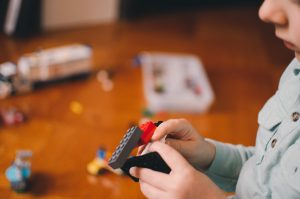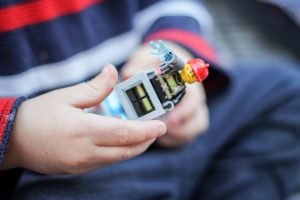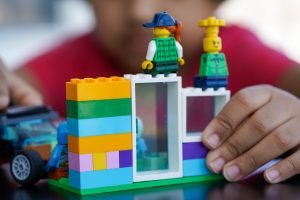Many adults struggle to control their anger and express it in healthy ways, so it should come as no surprise that children can also struggle with angry feelings, aggression, and uncontrollable angry outbursts. Some parents deal with anger issues in children by making excuses, trying to placate the child’s anger by giving in to their demands, or claiming that anger is good, and a child should be allowed to vent and express their feelings.
 While there may be a degree of truth to some of these ideas, children need to learn how to deal properly with their anger and to express it in constructive ways. Telling a child to “get over it” or to “be nice” may help now, but it does not teach them to handle critical moments in their lives.
While there may be a degree of truth to some of these ideas, children need to learn how to deal properly with their anger and to express it in constructive ways. Telling a child to “get over it” or to “be nice” may help now, but it does not teach them to handle critical moments in their lives.
Many parents wonder how to handle their children’s angry behavior, and they may even wonder if their behavior is normal. It is normal for children under four years old to have as many as nine tantrums a week, with outbursts sometimes lasting as long as 5-10 minutes. Mission Viejo Christian Counseling helps parents navigate these challenges with patience and effective strategies.
By kindergarten, most children have outgrown this behavior. If your child’s angry outbursts continue as they get older and begin causing problems at school, or with friends and family, it may be time to get some professional help.
One thing that anger does do is alert us to the fact that something is wrong, and it is the job of the mental health professional to determine what exactly the problem is, and how best to deal with it. Anger issues are the most common reason that children are referred for mental health treatment.
The most effective way to teach children to manage their anger is by example. If your children can see that you can be upset about something without losing control, that you can talk about why you’re angry and then let it go, it will show them that they can learn to do the same. Parents can also teach their children to talk to a trusted friend or relative when they’re feeling angry.
They can also teach their children simple anger management techniques like how to take time to cool down when something happens that upsets them.  Children can learn how to recognize when their body is starting to feel angry, and then to count to ten slowly or to breathe deeply when they feel themselves beginning to get angry.
Children can learn how to recognize when their body is starting to feel angry, and then to count to ten slowly or to breathe deeply when they feel themselves beginning to get angry.
Some children have never been taught that there are limits to how they should express their anger. And some parents have not supplied a healthy example for how to handle anger. If a parent is struggling with their own temper, it would be beneficial for them to seek professional help in controlling their anger, so that they can be better equipped to help their child.
But some children struggle to control their anger, even though their parents have set reasonable limits and been good examples to them. Believing that the children will just grow out of their anger as if it is just a phase they are going through constitutes a denial of a genuine problem. If the angry outbursts and disruptive behavior continue as the children get older, it may be necessary to get help.
Causes of anger
A variety of factors can contribute to children struggling with anger. It is commonly triggered by the frustration felt when a child doesn’t get what they want or is asked to do something that they don’t want to do. But in some cases, children’s anger issues are connected to other mental health conditions like Attention Deficit Hyperactivity Disorder (ADHD), autism, Obsessive-Compulsive Disorder (OCD), and Tourette’s syndrome. It may also be a symptom of depression.
Things like genetics and other biological factors or the child’s home environment may contribute to a child’s anger issues. A traumatic experience or family dysfunction may make it more likely that a child will experience anger issues that interfere with daily life. Certain parenting styles, like those with harsh, inconsistent punishment, may also play a role.
How are anger issues in children diagnosed?
When a child’s anger is out of control, it needs to be treated by a mental health professional. Anger issues may be related to other conditions like depression, bipolar disorder, Oppositional Defiant Disorder, or Antisocial Personality Disorder. Regardless of the label, anger issues need to be properly treated by a professional, because out of control anger may spiral into violence and end in a tragedy that could have been avoided.

As parents, you may wish to take your child for a psychological or psychiatric evaluation, or you may be referred by a pediatrician, psychologist, or teacher. Older children with behavioral problems may be sent for evaluation and treatment when they encounter the law courts or juvenile justice systems. The hope is that your child’s anger is treated appropriately before it gets this far.
A mental health professional will assess the extent of a child’s anger by looking at the child’s behavior in the context of their life. This will require input from parents and teachers, reviewing their academic progress, medical and behavioral records, and conducting one-on-one interviews with the child and the parent. They will look at the full spectrum of mental health disorders and how they might be affecting the child’s life.
Research-based measurement tools, such as answers given to specific questions, can help a psychologist to decide if a child meets the criteria for a behavioral disorder. A few potential diagnoses for a child struggling with irritability, anger, and aggression include Oppositional Defiant Disorder (ODD), Conduct Disorder (CD), or Disruptive Mood Dysregulation Disorder (DMDD).
What is the treatment for anger issues in children?
Treatment of a child’s anger issues may focus on two primary approaches: Cognitive Behavioral Therapy (CBT) and Parent Management Techniques (PMT). These are complementary therapies that will address the child’s behavior from different directions to change the interpersonal dynamics that lead to and result from angry outbursts.
 Cognitive Behavioral Therapy (CBT) will help a child learn new and effective strategies for regulating their angry emotions, thoughts, and behaviors. The child will learn emotional regulation by learning to identify anger triggers as well as preventative strategies; they will also learn different ways to safely express and deal with their frustration, and develop new communication strategies, practiced through role-playing, to help prevent and resolve situations that would provoke anger.
Cognitive Behavioral Therapy (CBT) will help a child learn new and effective strategies for regulating their angry emotions, thoughts, and behaviors. The child will learn emotional regulation by learning to identify anger triggers as well as preventative strategies; they will also learn different ways to safely express and deal with their frustration, and develop new communication strategies, practiced through role-playing, to help prevent and resolve situations that would provoke anger.
While CBT is done one-on-one with the child, the parents actively take part in the treatment and support the child’s progress towards learning anger management skills. Parent Management Techniques (PMT) will help parents limit outbursts by teaching them different ways to handle their child’s misbehavior.
Parent Management Techniques focus on using positive reinforcement for what a child does right, rather than punishment for transgressions. The biggest motivation for reducing angry outbursts becomes positive interactions as a family that enjoys spending time together.
If there are other mental health conditions involved, such as ADHD, anxiety, or depression, there may be a need for medication as part of the treatment plan. Cognitive-Behavioral Therapy and Parent Management Techniques are the main treatment for most anger issues, with a 65% success rate in reducing the frequency and the intensity of angry outbursts. There may, however, be some children that may require a more intensive outpatient, or even inpatient, treatment to get their anger under control.
A life of emotional intensity doesn’t feel good for the child, so apart from teaching anger management strategies, the focus of the mental health professional is to help the child feel better. When a child is happy, they will be much less likely to struggle with uncontrolled anger.
No parent wants to see their child unhappy. If you think your child may be struggling with anger issues, be sure to go to a doctor or a licensed mental health professional to get a proper diagnosis to begin your family’s journey toward a peaceful, happy home life. The Christian counselors at Mission Viejo Christian Counseling can provide faith-based support and practical tools to help your child manage their emotions in a healthy way.
“Building a Rocket”, Courtesy of Kelly Sikkema, Unsplash.com, CC0 License; “Building Stuff”, Courtesy of Nathan Dumlao, Unsplash.com, CC0 License; “Lego Toy”, Courtesy of Tim Cooper, Unsplash.com, CC0 License; “Playing with Legos”, Courtesy of Ravi Palwe, Unsplash.com, CC0 License










